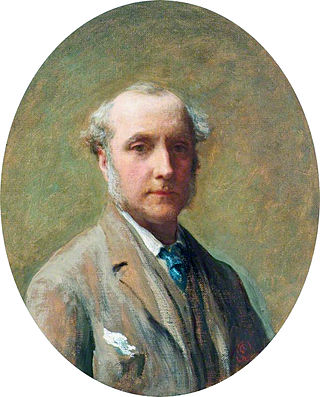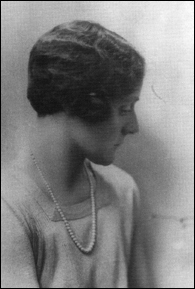Related Research Articles

William Dobson was a portraitist and one of the first significant English painters, praised by his contemporary John Aubrey as "the most excellent painter that England has yet bred". He died relatively young and his final years were disrupted by the English Civil War.

Sarah Biffin, also known as Sarah Biffen, Sarah Beffin or by her married name Mrs E. M. Wright, was an English painter born with no arms and only vestigial legs. She was born in 1784 in Somerset. Despite her disability she learned to read and write, and to paint using her mouth.

Ethel Campbell Louise Anderson was an early twentieth century Australian poet, essayist, novelist and painter. She considered herself to be mainly a poet, but is now best appreciated for her witty and ironic stories. Anderson has been described as "a high-profile author, artist, art commentator and emissary for modernism".

Frederick Yeates Hurlstone was an English painter. He was celebrated for his historical, portrait, and genre works, particularly scenes of Spanish and Italian rustic life. Trained under Sir William Beechey and Sir Thomas Lawrence, he won prestigious medals at the Royal Academy before focusing on exhibitions with the Society of British Artists, where he served as president from 1835 until his death. Known for works like The Last Sigh of the Moor and Italian Boys Playing the National Game of Mora, Hurlstone drew inspiration from travels to Italy, Spain, and Morocco, shifting to a "picaresco" style influenced by Murillo and Velázquez. Despite his opposition to the Royal Academy's management, he remained a prolific and influential figure, contributing over 300 works to exhibitions and earning international recognition, including a gold medal at the 1855 Exposition Universelle in Paris.

Stella Vine is an English artist, who lives and works in London. Her work is figurative painting, with subjects drawn from personal life, as well as from rock stars, royalty, and other celebrities.

Nora Heysen, was an Australian artist, the first woman to win the Archibald Prize in 1938 for portraiture and the first Australian woman appointed as an official war artist.
Janet Dawson MBE is an Australian artist who was a pioneer of abstract painting in Australia in the 1960s, having been introduced to abstraction during studies in England while she lived in Europe 1957–1960 She was also an accomplished lithographic printer of her own works as well as those of other renowned Australian artists, a theatre-set and furniture designer. She studied in England and Italy on scholarships before returning to Australia in 1960. She won the Art Gallery of New South Wales Archibald Prize in 1973 with the portrait of her husband, Michael Boddy Reading. She has exhibited across Australia and overseas, and her work is held in major Australian and English collections. In 1977 she was awarded an MBE for services to art.

Anna Airy was an English oil painter, pastel artist and etcher. She was one of the first women officially commissioned as a war artist and was recognised as one of the leading women artists of her generation.

James Sant (1820–1916) was a British painter specialising in portraits and known particularly for images of women and children and artistic exploration of the symbolism of childhood. He was a member of the Royal Academy. George Sant and Sarah Sant were also artists and are believed to have been his brother and sister.

Henry Bright, was a distinguished English landscape painter associated with the Norwich School of painters.

Margaret Sarah Carpenter was an English painter. Noted in her time, she mostly painted portraits in the manner of Sir Thomas Lawrence. She was a close friend of Richard Parkes Bonington.

Eliza Turck (1832–1891), was an English portrait, genre, bird and landscape painter, illustrator and writer.
Nicola Jane Philipps, sometimes referred to as Nicky Philipps, is a British artist who rose to prominence in the 2000s as a contemporary portraitist. She painted the first double portrait of Princes William and Harry in 2010.

George Dunlop Leslie was a British genre painter, author and illustrator.

Anna Mary Howitt, Mrs Watts was an English Pre-Raphaelite professional (history) painter, professional writer, women's rights activist and spiritualist. Following a health crisis in 1856, she exhibited rarely as a painter, but continued to work as a professional writer. She became a pioneering drawing medium. It is likely the term "automatic drawing" originated with her. She was involved in the married women property committee.

Florence Ada Fuller was a South African-born Australian artist. Originally from Port Elizabeth, Fuller migrated as a child to Melbourne with her family. There she trained with her uncle Robert Hawker Dowling and teacher Jane Sutherland and took classes at the National Gallery of Victoria Art School, becoming a professional artist in the late 1880s. In 1892 she left Australia, travelling first to South Africa, where she met and painted for Cecil Rhodes, and then on to Europe. She lived and studied there for the subsequent decade, except for a return to South Africa in 1899 to paint a portrait of Rhodes. Between 1895 and 1904 her works were exhibited at the Paris Salon and London's Royal Academy.

Kathleen "Kay" Moir Morris was a Canadian painter and although not an official member of the Beaver Hall Group, she often is counted as a member since she was friendly with many of its members and exhibited with them.

Barnett Samuel Marks R.C.A. was a Welsh-Jewish portrait painter who was also noted for his social realism paintings.

Robert Weir Allan (1851–1942) was a Scottish-born painter known mainly for his depiction of landscape and marine subjects. He was born in Glasgow into a family that encouraged and valued his natural artistic ability. He exhibited at the Glasgow Institute of the Fine Arts when aged 22, and two years later he had a painting selected for the Royal Academy, in London. In 1875–80 he attended the Académie Julian in Paris, and he was influenced by the French school of rustic naturalism and also by French Impressionism. Working plein-air, he developed a loose, painterly approach to landscape subjects. He was a prolific artist who travelled widely in Europe, India, Japan, the Middle East and America; however, he drew particular inspiration from the north-east coast of Scotland – a subject to which he returned throughout his life. He exhibited extensively in London, Glasgow and Edinburgh, and became vice-president of the Royal Society of Painters in Water Colours. He was equally at home with oil painting, and during his lifetime he had 84 paintings selected for exhibition at the Royal Academy. For the last 60 years of his life his home was in London, and he died there at the age of 90 in 1942.

Frances Caroline Fairman was a British watercolourist, a painter in oils, and an illustrator. In her lifetime she was best known for her canine portraits, some of which were commissioned by royalty and aristocracy. She was known as "the Lady Landseer" for the quality of her work. She travelled to the Americas, France, and Switzerland, returning with watercolour landscape sketches.
References
- 1 2 A Checklist of Painters, C1200-1994 Represented in the Witt Library, Courtauld Institute of Art, London. Taylor & Francis. 1995. p. 340. ISBN 9781884964374.
- ↑ England, Select Births and Christenings, 1538-1975, ancestry.co.uk
- ↑ Church of England Marriages and Banns, 1754-1932, ancestry.co.uk
- ↑ "Fitzroy Square". British History Online. Archived from the original on 2 May 2015. Retrieved 23 February 2020.
- 1 2 Census Returns of England and Wales, 1901. Kew, Surrey, England: The National Archives, 1901
- ↑ The National Archives of the UK (TNA); Kew, Surrey, England; Census Returns of England and Wales, 1891
- ↑ Lloyd's Weekly Newspaper, Sunday 31 December 1871
- 1 2 L. Melville, Eliza Alex (1871). $2,000 reward. London: Dean & Son. pp. v - x and 177–184.
- ↑ England & Wales, Civil Registration Death Index, 1916-2007, ancestry.co.uk
- ↑ Leslie-Melville, Eliza. "Eliza Anne Leslie-Melville". Burial Grounds. Retrieved 18 January 2025.
- ↑ "Burial Register Summary". Deceased Online. Retrieved 23 February 2020.
- 1 2 Wood, Christopher (1995). Victorian Painters: The text. Antique Collectors' Club. p. 350. ISBN 9781851491711.
- 1 2 Grainger, Jacqui. "Women, the Institute and the Collections". RUSI. Archived from the original on 7 June 2019. Retrieved 22 February 2020.
- ↑ Petteys, Chris (1985). Dictionary of Women Artists: an international dictionary of women artists born before 1900. G.K. Hall & Co.
- ↑ Graves, Algernon (1884). A Dictionary of Artists who have exhibited in the Principal London Exhibitions of Oil Paintings from 1760-1880. London: George Bell and Sons. pp. 226.
- ↑ Graves, Algernon (1906). The Royal Academy of Arts: a complete dictionary of contributors and their work from its foundation in 1769 to 1904, Volumes 5-6. London: Henry Graves and Co. Ltd. pp. 227.
- ↑ Morning Post, Friday 10 July 1868
- 1 2 Morning Advertiser, Saturday 13 July 1867
- ↑ Morning Post, Friday 23 November 1866
- ↑ Morning Post, Saturday 13 July 1867
- 1 2 Welch, Charles (1896). Modern History of the City of London. London: Blades East & Blades. pp. 276 and 287.
- ↑ London City Press, Saturday 4 July 1868
- ↑ The Art Journal. London: Virtue & Co. 1868. pp. 38.
- ↑ Morning Post, Friday 28 November 1873
- ↑ Exmouth Journal, Saturday 19 March 1870
- ↑ Globe, Saturday 13 January 1877
- ↑ London Daily News, Friday 27 February 1880
- ↑ "Exhibition Details". Exhibition Culture in London 1878-1908. Retrieved 23 February 2020.
- ↑ Pall Mall Gazette, Thursday 11 June 1885
- ↑ "McQueen's Gallery". London Gallery Project. Archived from the original on 11 August 2017. Retrieved 22 February 2020.
- ↑ Alnwick Mercury, Saturday 29 August 1885